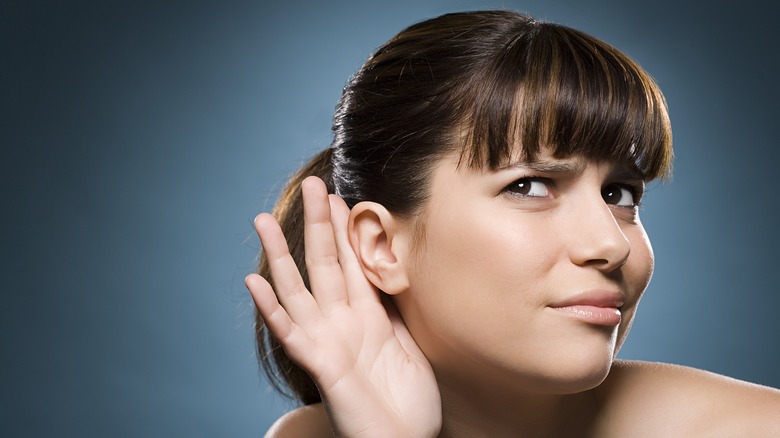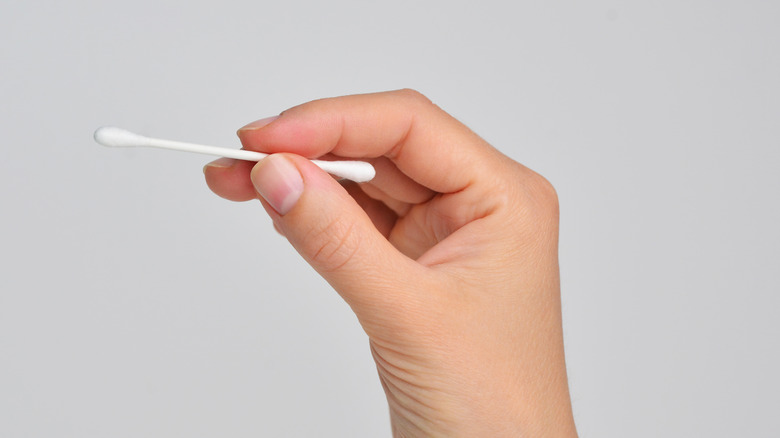Is It Really Smart To Use Cotton Swabs To Clean Your Ears?
It's not like having water in your ear, which you can usually feel swish around. And it doesn't hurt like an earache often does. It often creates a muffling sensation, which can make your own voice echo to the point of distraction. The likely culprit? Earwax, which you probably want to remove so that you can return to hearing, speaking, and swallowing as usual. Before you go on the offensive, though, it may help to remember that some earwax is not just normal but also a positive influence, Healthline says. Also known as cerumen, earwax traps dust and debris — blocking them from traveling deep in the ear and becoming wedged there, WebMD says. Earwax is also somewhat acidic, which means it's a natural bacteria fighter, says Dr. Yu-Tung Wong of Cedars Sinai.
This is not to suggest that you should tolerate earwax. But you should consider that it has a way of working its way out of your ear naturally, even when you're unaware of it moving, like when you're sleeping or taking a shower. Physicians have seen people use a wide range of objects to remove earwax, including hair clips, tweezers, paper clips, straws, and cotton swabs, Healthy Hearing says. Of this group, long, narrow cotton swabs seem tailor-made for the job. Or are they?
Cotton swabs act like plungers, not spoons
If you're likening cotton swabs to little spoons that scoop out earwax, the imagery is all wrong. Cotton swabs act more like plungers, pushing earwax deeper and deeper into the ear canal until it becomes trapped, says Dr. Yu-Tung Wong of Cedars Sinai. At some point — usually the noticeable absence of earwax on the swab — the futility of this exercise may become obvious. Many people tend to overcompensate and excavate with even greater force. This is often why some people end up puncturing their eardrums and suffering hearing loss as a result.
This can be a more painful ordeal than it seems, particularly when you start with the premise that ear drums are inherently fragile entities. Even the slightest push from a cotton swab can cause an eardrum to burst, and the pain can be severe, Healthy Hearing says. In time and with treatment, the ear can heal. But the lesson it imparts can be painfully brutal: Do not use cotton swabs to clean out your ears.
At the risk of adding insult to injury, Dr. Wong suggests taking a long view of any muffled or vibrating sensation in your ear. Chances are, it's temporary. Plus, even if there were a huge waxy buildup in your ear, the canal could be up to 90% blocked, and you'd still be able to hear. Such is the wonder of the human ear that sound can travel through the tiniest pinhole.
In the worst of cases, clean your ears
It wouldn't be the strangest thing to go most (or even all) of your adult life without undertaking a special effort to clean your ears. Unlike every other part of your body, your ear canal is the one body part that does not require special treatment. This is because water enters your ear canal as you shampoo your hair or shower, loosening earwax so that it escapes on its own (again, during sleep, as you shower, or when you flip your hair as you dry it, Healthy Hearing says.
However, if that muffled feeling persists or starts to make you feel dizzy or nauseous, you may have to take a more assertive approach. Healthline says you can begin by wiping the outside of your ear with a damp, warm washcloth. You'd use the same gentle surface movement as you would to clean out your ears after an afternoon at the beach, Penn Medicine News says.
Admittedly, this offers a limited range that may leave you right where you started. In this case, try inserting any number of oils that function as ear drops to soften the wax. You can purchase the oils over the counter, though some may already be stored in your medicine cabinet. They include baby oil, glycerin, hydrogen peroxide, mineral oil, peroxide, and saline. All of them are as soothing as they sound — and treat earwax with the light touch that it responds to best.


